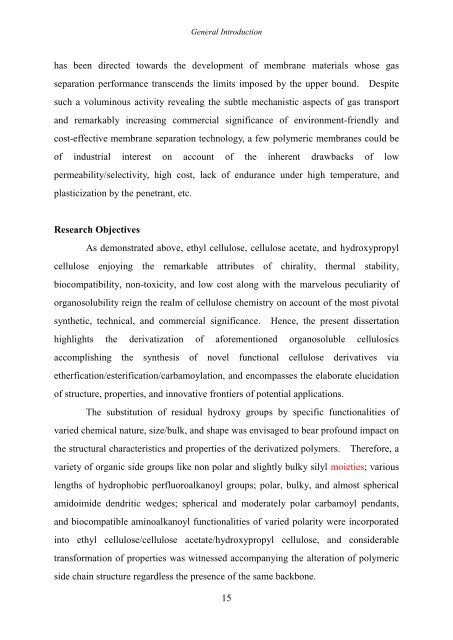Synthesis, Characterization, and Gas Permeation Properties
Synthesis, Characterization, and Gas Permeation Properties
Synthesis, Characterization, and Gas Permeation Properties
You also want an ePaper? Increase the reach of your titles
YUMPU automatically turns print PDFs into web optimized ePapers that Google loves.
General Introduction<br />
has been directed towards the development of membrane materials whose gas<br />
separation performance transcends the limits imposed by the upper bound. Despite<br />
such a voluminous activity revealing the subtle mechanistic aspects of gas transport<br />
<strong>and</strong> remarkably increasing commercial significance of environment-friendly <strong>and</strong><br />
cost-effective membrane separation technology, a few polymeric membranes could be<br />
of industrial interest on account of the inherent drawbacks of low<br />
permeability/selectivity, high cost, lack of endurance under high temperature, <strong>and</strong><br />
plasticization by the penetrant, etc.<br />
Research Objectives<br />
As demonstrated above, ethyl cellulose, cellulose acetate, <strong>and</strong> hydroxypropyl<br />
cellulose enjoying the remarkable attributes of chirality, thermal stability,<br />
biocompatibility, non-toxicity, <strong>and</strong> low cost along with the marvelous peculiarity of<br />
organosolubility reign the realm of cellulose chemistry on account of the most pivotal<br />
synthetic, technical, <strong>and</strong> commercial significance. Hence, the present dissertation<br />
highlights the derivatization of aforementioned organosoluble cellulosics<br />
accomplishing the synthesis of novel functional cellulose derivatives via<br />
etherfication/esterification/carbamoylation, <strong>and</strong> encompasses the elaborate elucidation<br />
of structure, properties, <strong>and</strong> innovative frontiers of potential applications.<br />
The substitution of residual hydroxy groups by specific functionalities of<br />
varied chemical nature, size/bulk, <strong>and</strong> shape was envisaged to bear profound impact on<br />
the structural characteristics <strong>and</strong> properties of the derivatized polymers. Therefore, a<br />
variety of organic side groups like non polar <strong>and</strong> slightly bulky silyl moieties; various<br />
lengths of hydrophobic perfluoroalkanoyl groups; polar, bulky, <strong>and</strong> almost spherical<br />
amidoimide dendritic wedges; spherical <strong>and</strong> moderately polar carbamoyl pendants,<br />
<strong>and</strong> biocompatible aminoalkanoyl functionalities of varied polarity were incorporated<br />
into ethyl cellulose/cellulose acetate/hydroxypropyl cellulose, <strong>and</strong> considerable<br />
transformation of properties was witnessed accompanying the alteration of polymeric<br />
side chain structure regardless the presence of the same backbone.<br />
15

















